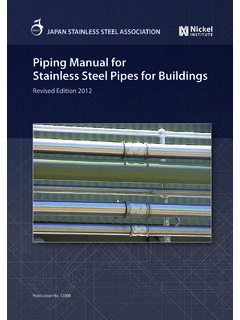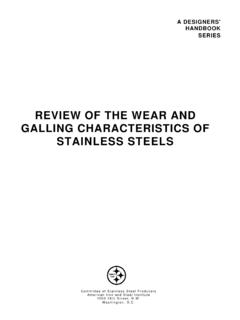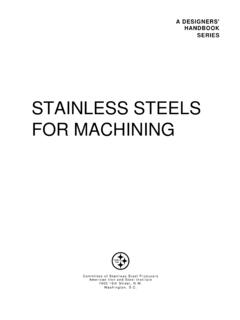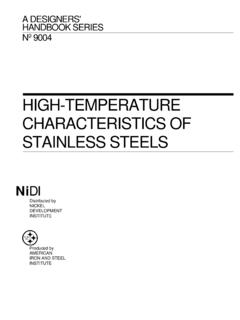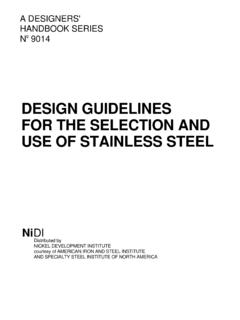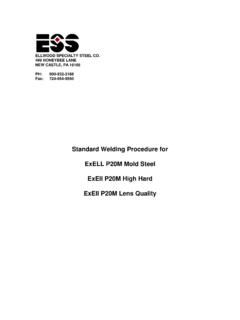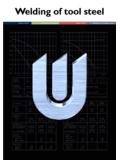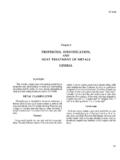Transcription of WELDING OF STAINLESS STEELS AND OTHER JOINING …
1 A DESIGNERS' HANDBOOK SERIES No 9002 WELDING OF STAINLESS STEELS AND OTHER JOINING methods NiDl Distributed by NICKEL DEVELOPMENT INSTITUTE Produced by AMERICAN IRON AND steel INSTITUTE 2 Much of the information in this handbook was presented at a symposium sponsored by the Committee of STAINLESS steel Producers, American Iron and steel Institute, 1133 15th Street, NW, Washington, DC 20005, , in co-operation with ASM International (formerly American Society of Metals), Metals Park, OH 44073, Subsequent to the symposium, ASM International published a book, JOINING of STAINLESS STEELS . Tables and charts, which are not given references in this publication, were obtained either from the ASM International book or from OTHER sources within the STAINLESS steel industry in the United States.
2 It should be noted that the data are typical or average values. Materials specifically suggested for applications described herein are made solely for the purpose of illustration to enable the reader to make his own evaluation. Originally, this handbook was published in 1979 by the Committee of STAINLESS steel Producers, American Iron and steel Institute. The Nickel Development Institute reprinted it for distribution in August 1988. Material presented in the hand-book has been prepared for the general information of the reader and should not be used or relied on for specific applications without first securing competent advice. The Nickel Development Institute and American Iron and steel Institute, their members, staff and consultants do not represent or warrant the material's suitability for any general or specific use and assume no liability or responsibility of any kind in connection with the information herein.
3 Introduction STAINLESS STEELS are engineering materials capable of meeting a broad range of design criteria. They exhibit excellent corrosion resistance, strength at elevated temperature, toughness at cryogenic temperature, and fabrication characteristics and they are selected for a broad range of consumer, commercial, and industrial applications. They are used for the demanding requirements of chemical processing to the delicate handling of food and pharmaceuticals. They are preferred over many OTHER materials because of their performance in even the most aggressive environments, and they are fabricated by methods common to most manufacturers. In the fabrication of STAINLESS steel products, components, or equipment, manufacturers employ WELDING as the principal JOINING method.
4 STAINLESS STEELS are weldable materials, and a welded joint can provide optimum corrosion resistance, strength, and fabrication economy. However, designers should recognize that any metal, including STAINLESS STEELS , may undergo certain changes during WELDING . It is necessary, therefore, to exercise a reasonable degree of care during WELDING to minimize or prevent any deleterious effects that may occur, and to preserve the same degree of corrosion resistance and strength in the weld zone that is an inherent part of the base metal. The this booklet is to help designers and manufacturing engineers achieve a better understanding of the WELDING characteristics of STAINLESS STEELS , so they may exercise better control over the finished products with respect to WELDING .
5 In addition to WELDING , OTHER ancillary JOINING methods are discussed, including soldering and brazing. 3 Contents INTRODUCTION ..2 STAINLESS steel WELDING CHARACTERISTICS 4 Austenitic STAINLESS STEELS .. 4 Preservation of Corrosion Resistance .. 6 Carbide Precipitation .. 6 Stress-Corrosion Cracking .. 7 Prevention of Cracking .. 7 WELDING Procedures .. 9 Martensitic STAINLESS STEELS .. 9 WELDING Procedures .. 10 Ferritic STAINLESS STEELS .. 11 Preservation of Corrosion Resistance .. 11 WELDING Procedures .. 11 Precipitation Hardening STAINLESS STEELS .
6 11 Influence of Elements in Weld Environment .. 12 Oxygen .. 12 Carbon .. 12 Nitrogen .. 12 Hydrogen .. 12 Copper or Lead .. 12 Influence of Alloying Elements on Weldability .. 12 Influence of Alloying Elements on Weld Structure .. 12 Weld Rod Selection .. 13 Austenitic STAINLESS STEELS .. 13 Martensitic STAINLESS STEELS .. 13 Ferritic STAINLESS STEELS .. 13 Precipitation Hardening STAINLESS STEELS .. 13 WELDING PROCESSES FOR STAINLESS STEELS . 15 Fusion WELDING .. 15 Shielded Metal Arc WELDING .. 15 SMAW Electrodes.
7 15 Gas Tungsten Arc WELDING .. 16 Filler Rod Selection .. 18 GTAW Equipment .. 18 Gas Metal Arc WELDING .. 18 Spray Arc WELDING .. 18 Short Circuiting Type Transfer .. 19 Pulsed Arc WELDING .. 20 WELDING Wires .. 20 Minimizing Hot Cracking .. 21 Summary .. 21 Submerged Arc WELDING .. 21 Description of Equipment .. 22 Strip Electrodes .. 22 Plasma-Arc WELDING .. 22 Circumferential Pipe WELDING .
8 23 Plasma-Arc WELDING Equipment .. 23 Gases .. 23 Low-Current Plasma-Arc WELDING .. 24 Electron Beam WELDING .. 24 Equipment .. 24 Laser WELDING .. 25 Resistance WELDING .. 26 Spot WELDING .. 26 Electrodes .. 28 Precautions .. 28 Seam WELDING .. 28 Projection WELDING .. 28 Butt WELDING Process .. 30 Flash WELDING .. 30 Upset WELDING .. 31 High Frequency Resistance WELDING .. 32 Percussion WELDING .
9 32 Conclusion .. 32 Friction WELDING .. 32 Electroslag WELDING .. 32 STAINLESS steel PIPE WELDING .. 32 Backing Rings .. 33 WELD OVERLAYS .. 33 WELDING Electrodes .. 33 WELDING OF STAINLESS steel -CLAD PLATE .. 33 WELDING DISSIMILAR METALS .. 35 Austenitic STAINLESS STEELS to Low Carbon STEELS .. 35 Procedures for WELDING Transition Joints .. 36 Ferritic and Martensitic STAINLESS STEELS to Carbon or Low-Alloy STEELS .. 36 USE OF CHILL BARS .. 37 JOINT DESIGN .. 37 Preparation .. 38 POST WELD CLEANING AND FINISHING .. 38 Weld Spatter.
10 38 Flux Removal .. 38 Finishing Welds .. 39 MECHANICAL PROPERTIES .. 40 CUTTING STAINLESS steel .. 42 Iron Powder/Flame Cutting .. 42 Plasma Jet Cutting .. 42 SOFT SOLDERING .. 42 Proper Cleaning a Must .. 43 Selection of the Proper Flux .. 43 Selection of the Proper Solder .. 43 Cleaning After Soldering .. 43 BRAZING .. 43 Heating methods .. 45 Joint Design .. 45 Precleaning .. 45 Selection of Brazing Filler Metal .. 46 Brazing Flux .. 46 Postcleaning .. 46 4 STAINLESS steel WELDING Characteristics By definition, STAINLESS STEELS are iron-base alloys containing 10% or more chromium, which imparts to the metal the corrosion-resistant properties for which STAINLESS STEELS are so highly regarded.

